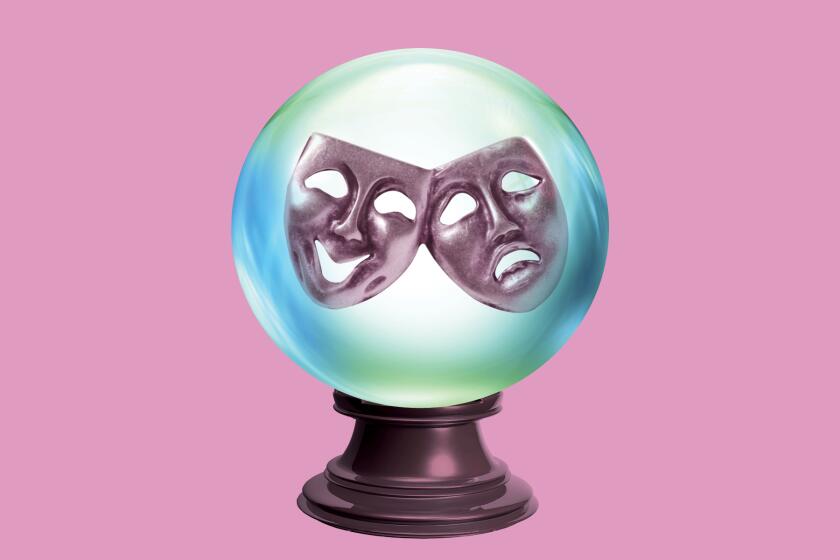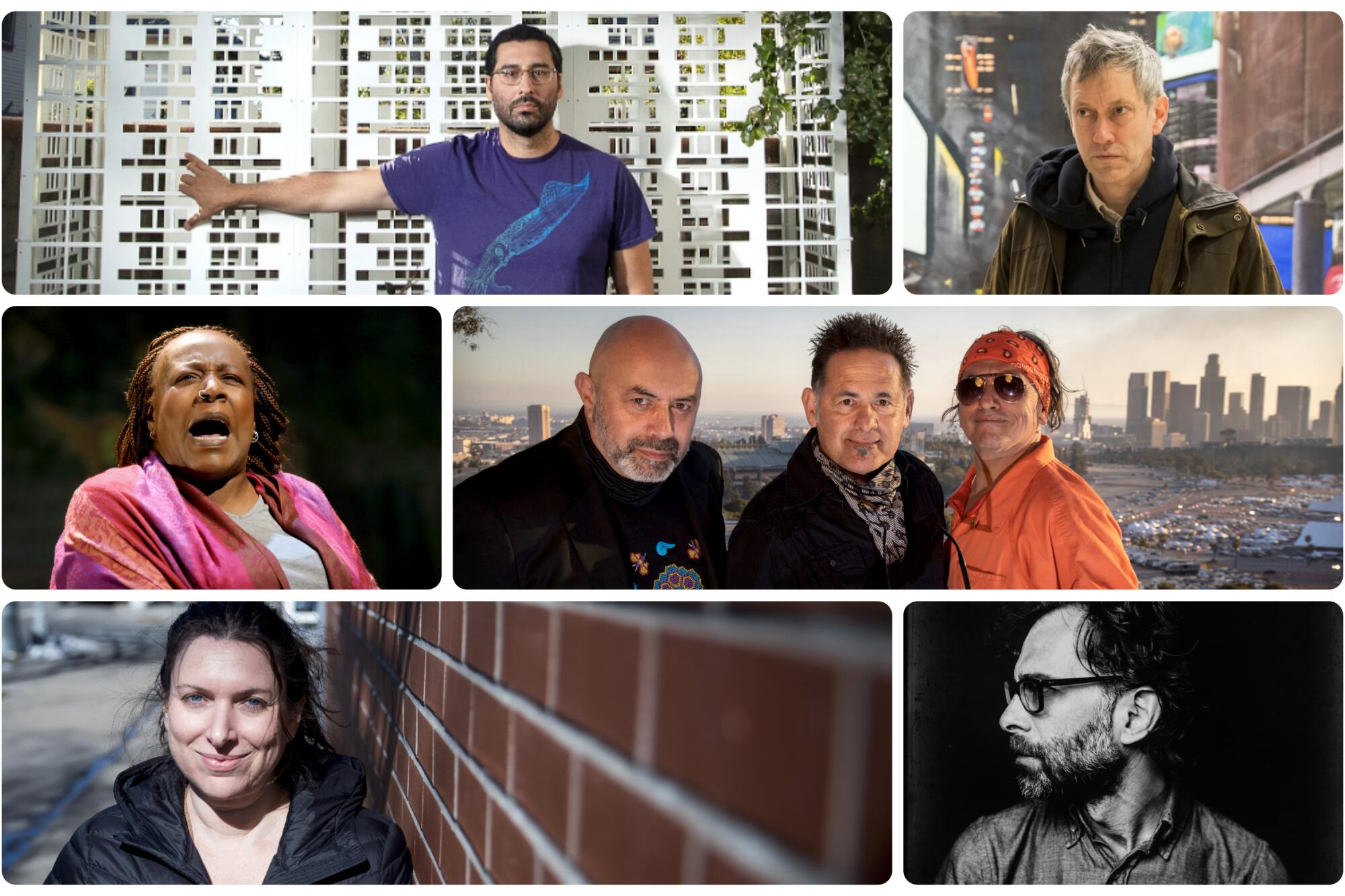
- Share via
No sector of the performing arts has been unscathed by the COVID-19 pandemic. But I’ve been especially concerned about the plight of theater stalwarts, those pioneers and purists who haven’t been biding their time in rehearsal rooms, waiting for their Netflix closeups. For directors, playwrights and performance artists whose canvas is the three-dimensional stage, the situation has been unimaginably dire.
How have they been getting by, creatively and financially? I feared tales of Dickensian hardship, but I came away from my conversations with director Daniel Fish, the performance troupe Culture Clash, playwright and performer Dael Orlandersmith, director and visual artist Lars Jan, director Annie Dorsen and playwright and director Richard Maxwell heartened by their tenacity and resilience.
These theater makers are well-versed in the art of survival. This has been a gut-wrenching time for them, but they’ve risen to the challenge with the same ingenuity and courage they’ve shown in their pathbreaking work.
As the one-year anniversary of the COVID-19 pandemic arrives, we want to hear from Angelenos in the theater industry about what life has been like since.
• • •
Daniel Fish
In 2019, director Daniel Fish was riding high. His invigorating deconstruction of “Rodgers and Hammerstein’s Oklahoma!” won the Tony Award for best musical revival. Last March, just before the pandemic closed the theaters, he was in a workshop rehearsal for a new show based on Frank Loesser’s “The Most Happy Fella.”
“I was taking a lot of the music and rethinking it on different kinds of people, different kinds of bodies and different kinds of voices,” Fish recalled. “We had to cut rehearsals short by about four days, and on March 12 we stopped. We hadn’t really found the piece, but just before we left, we ran through what we had. I was really glad I was in the room because it was a great run. I think everybody had a feeling that they didn’t know the next time they’d be in a room with other actors again. So there was a sense of mortality about it and a sense of urgency, and then we all went away.”
Fish returned home to Brooklyn to wait out the pandemic. He owns his apartment, and he’s been getting by through a combination of unemployment benefits and his savings.
“At first, we all thought by July everything would be fine,” he said with a laugh. “And of course it wasn’t. That dynamic has followed across the board — of thinking something might happen, then having it pushed back again, then having lots of Zoom meetings about how to rethink projects if they happen and then them not happening. The number of hours I’ve spent doing that has been significant and wearying.”
The World Health Organization announced the coronavirus outbreak had become a pandemic on March 11, 2020. Since then, the virus has seemingly touched all aspects of life in Southern California and beyond. The Times looks back on a full year of life in a pandemic.
When we talked on Zoom, he was still figuring out what do about the prospect of losing his health insurance from his theatrical union, the Stage Directors and Choreographers Society. This is a widespread problem for members who haven’t been working enough in the last year to maintain the benefit. But Fish was quick to point out that he’s healthy, housed and aware that people have been affected much more severely than he has.
The psychological toll, however, can’t be dismissed. “I’m by nature not the most social person in the world,” he said. “My social life has always just been being in a rehearsal room. I’m content to be at home. But I’m missing this whole other kind of social interaction, which happens as a result of making work for the stage.”
Fish has found solace elsewhere. Initially, he took the pause as an opportunity to look at things more slowly — literature, the city around him, even the patterns of his own thought.
“I’ve been reading a lot, especially poetry,” he said. “Since September, after the art galleries and museums reopened in New York, I’ve been seeing as much art as I can. Once a week I go just to be in the room with something, and that has saved my mind a little bit.”
Digital performance for him is something of an oxymoron. “Theater happens in the moment,” he explained. “What I’m interested in is people being alone and together in a room. That’s just the fact of it. So on the most basic level, it’s just impossible to do.”
Although he knows colleagues have been doing innovative things online, the work doesn’t appeal to him all that much as an audience member or as an artist. “Making work for film and the camera does, but Zoom is different. And I’ve been questioning the impulse in myself and others to produce right away,” he said. “This notion that we have to do something, that we have to find other ways to work. I was like, ‘Hello, this is an opportunity to just stop. Everybody just stop. Can we really not do that?’ I would say my track record is 50-50, but I’m more interested in looking than forcing things out.”
That said, he has many projects lined up, including an opera in France next year, a film inspired from the meditative city walks he’s been taking during the pandemic, and a song cycle video production with composer Ted Hearne and visual artist Rachel Perry for UCLA’s Center for the Art of Performance. His production of “Oklahoma!” is scheduled to reopen the Ahmanson Theatre at the end of August, though Fish is aware that all dates are now written in sand.
“A colleague said to me last week, ‘I just wish someone had told me in March that it’s going to be one year or 16 months, and then I would have thought about things differently.’ It’s this constant state of postponement and uncertainty. As a result, I’m working on 10 different things, but none of them are going anywhere. It’s very different than going into a room with people and making something. I’m envious of writers and painters right now, but, for better or worse, I have to do it in a room with people. And I can’t do it in a virtual room, or I’m just not that interested in doing it in a virtual room.”
• • •
Richard Montoya, Ric Salinas and Herbert Siguenza of Culture Clash
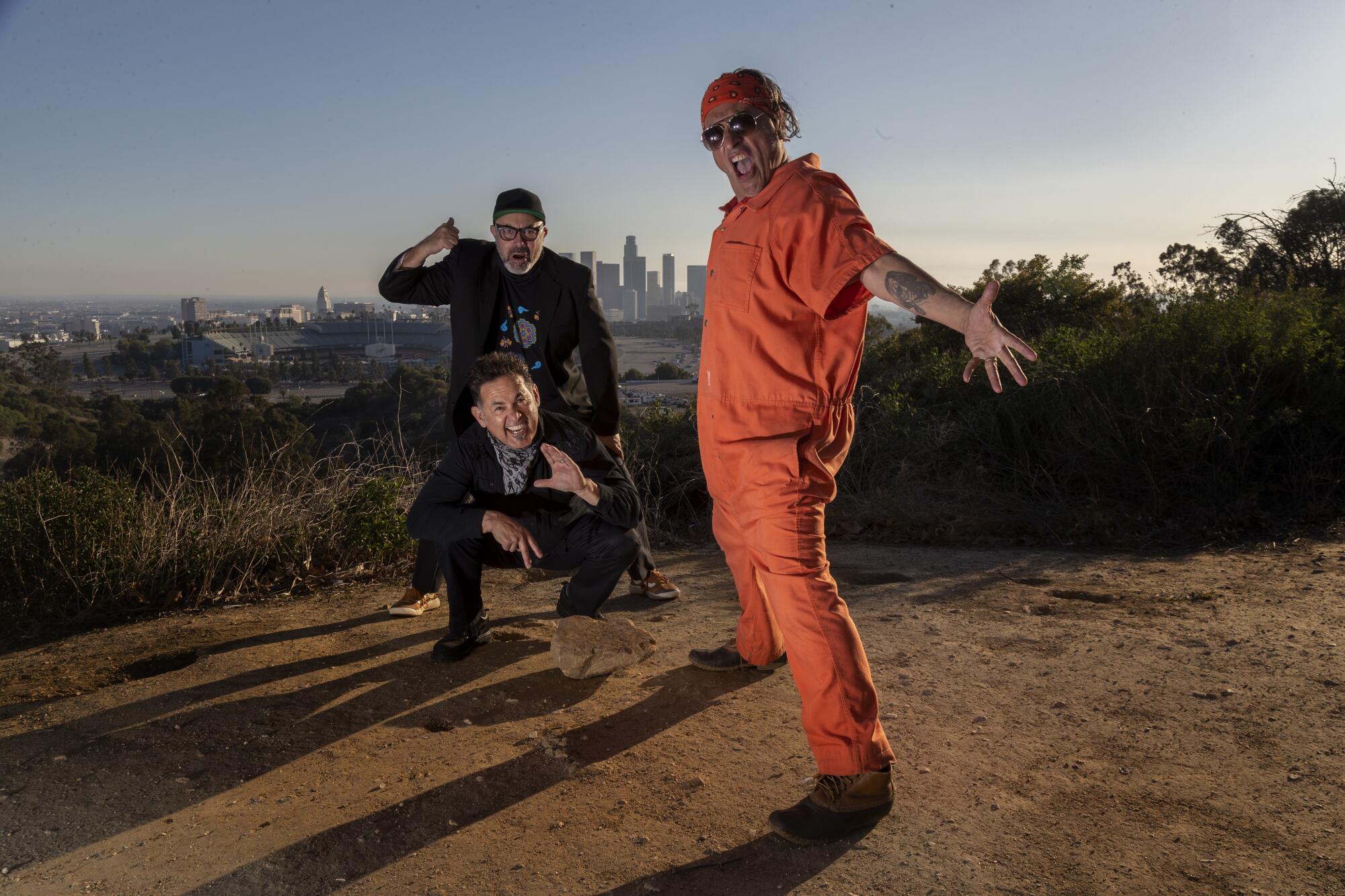
Richard Montoya, Ric Salinas and Herbert Siguenza, the trio known as Culture Clash, were at Berkeley Repertory last winter with their show “Culture Clash (Still) in America.” The production was an instant hit with Bay Area theatergoers, who were eager to welcome back these zany political satirists at a time when there was so much insanity to skewer.
Buzz was building, tickets were selling fast and the laughter was expected to continue through the beginning of April. But the group received a phone call while teaching a class at UC Berkeley: COVID-19 was spreading, and the show would have to close early.
“We were shocked,” recalled Montoya on a lively Zoom call with his Culture Clash comrades. “Like a lot of performers, we thought we’d never work again. You get that last check and you’re like, ‘I guess we’re going to clean pools! There’ll always be gardening work in Los Angeles!’”
Fortunately, decades in the theater had prepared these troupers for worst-case scenarios.
“We’re writer-performers,” Siguenza said. “That’s what saved us all these years. If you sit around waiting for a Latinx part, you’re never going to get it. We have survived by being the creators of our own destiny.”
Salinas described Culture Clash as a “small business, without the brick and mortar.” The last few years, he said, have been especially busy, with productions at the Getty Villa, Pasadena Playhouse and South Coast Repertory. The abrupt end of the Berkeley Rep run felt like a crash without airbags.
But the Culture Clash hotline didn’t stay quiet for long. Invitations began coming in from theaters needing to expand their virtual programming.
“When the shutdown happened, all the theater companies became television stations essentially,” Siguenza said. “And we have a lot of experience doing short-form theater. We’re good at the five-minute sketch. So people have been reaching out to hire us.”
“This is a town where our 35-year history is not always a plus,” Montoya said. “But at least 25 of those years have been involved with social justice, and those relationships have been very key in the last year. So for an august group such as ours to get a call from CTG [Center Theatre Group] to say, ‘You have a home. Don’t freak out.’ Or Christopher Ashley at La Jolla Playhouse to ask, ‘What does the digital world look like for you guys?’ Berkeley Rep says, ‘We’re doing a podcast.’ And then you patch together what you do as performer-writers. We’re guiltily a little busy.”
For La Jolla Playhouse, Culture Clash presented six episodes of an online series titled “The Totally Fake Latino News With Culture Clash.” Montoya said the series had more than 600,000 views. “Those aren’t theater numbers,” he added.
“I don’t know what appealed to them,” Siguenza said. “The title maybe. But we were getting people from Brazil, Mexico, Japan watching. They didn’t know Culture Clash. They just thought this is funny, this is cool, I can invest 12 minutes in it. I don’t have to sit through 12 hours of Ibsen.”
Culture Clash’s brand of politically ballsy sketch comedy is a perfect fit for the times. “Does the moment need laughs or seriousness?” Montoya asked. “We’re playing with the clay, and it’s pliable. I think what’s happened is the pandemic and Black Lives Matter have oddly opened this door a little bit to us.”
“We’ve been talking about Black Lives Matters, Latino Lives Matters, all those matters,” Siguenza said. “We’ve been talking about people of color for 30 years. Suddenly, it’s the big catchphrase, but we’ve been talking about it all along.”
“It’s almost as if the times caught up with us,” said Salinas. “That’s why we didn’t break up!”
Siguenza puckishly jumped in: “Then we have little Latinx theater makers saying, ‘You can’t say that, Herbert. You’re old school.’ OK, I respect it, whatever.”
“I think the Latinx conversation has been interesting for three gentlemen of a certain vintage,” said Montoya. “It was Branford Marsalis, after the patriarch of that dynasty died, who said that this was going to be a time for seasoned voices. I feel like we’re ready to step into our veteranos shoes.”
Center Theatre Group made Culture Clash part of its Creative Collective, which was established through a $200,000 grant from an anonymous donor to explore what theater could be in this period of crisis. Filming is underway for a serialized retelling of “Chavez Ravine,” a classic in the group’s repertoire, which will unfold in nine digital installments. A release date hasn’t been set, but a spokesperson for CTG expects it will be sometime in the summer. Montoya promised a serious reexamination, informed by the troubling parallels between L.A.’s problematic past and pandemic present.
“It’s a stalemate with the theaters right now,” Salinas said. “We don’t know when we’re going to be in front of an audience, so there’s a vacuum. But working in theater on streaming services, first with La Jolla Playhouse and now with Center Theatre Group, has been keeping us alive.”
“It’s been a season of death,” said Montoya.
“Just half a generation ahead of us, those were all our heroes, and a lot of them have died,” Siguenza said. He mentioned Noe Montoya from El Teatro Campesino. But the losses have gone beyond COVID-19. The death of CTG associate artistic director Diane Rodriguez, who died from cancer last year, hit them especially hard.
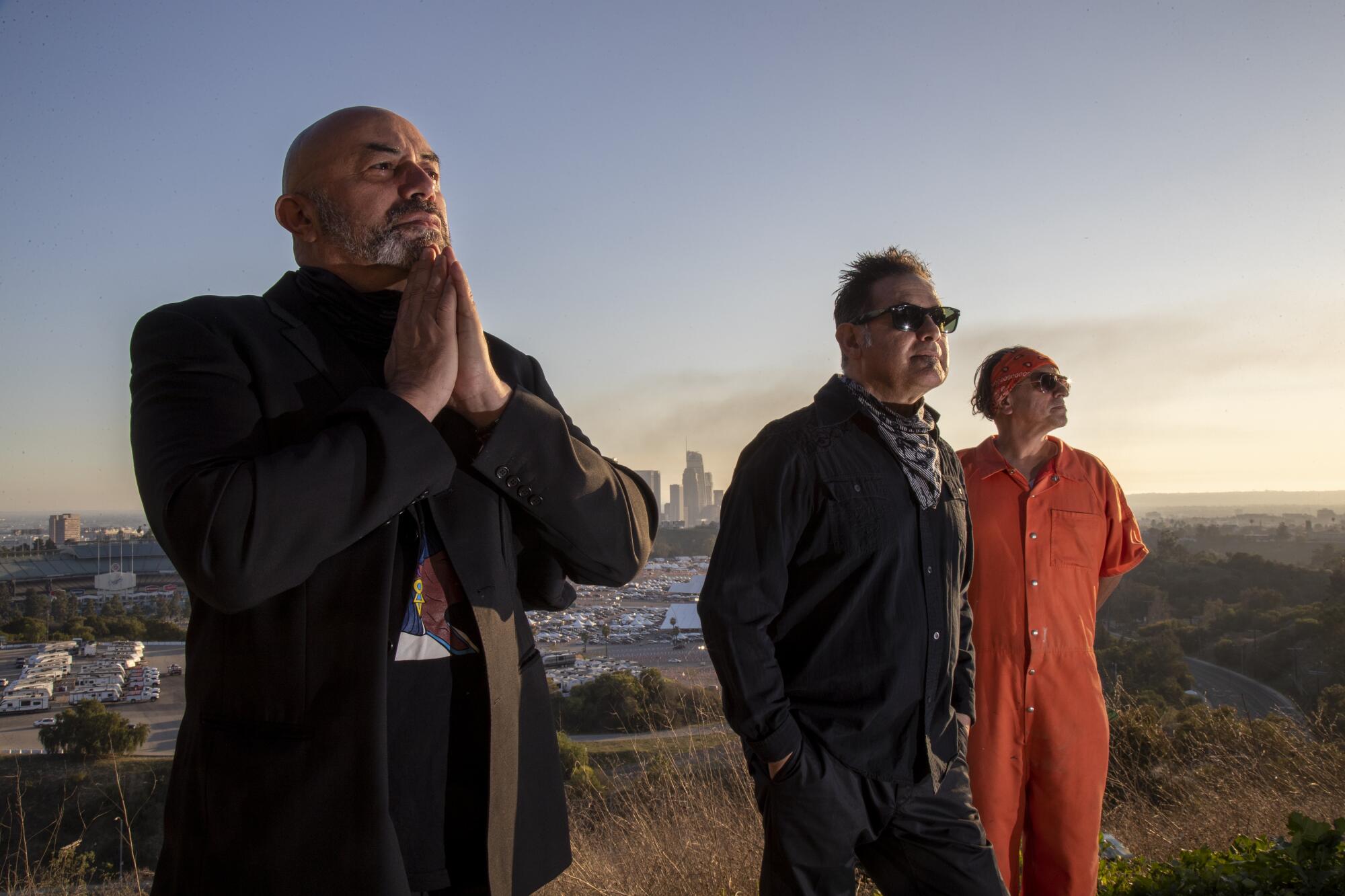
“Our troops have been a little decimated,” Montoya said mournfully. “Diane Rodriguez and then Dr. Kerry English, who was a Cornerstone Theater Company board member. These people have been to our homes. We’ve celebrated weddings with them. It’s been a costly year. Even the passing of Kobe Bryant kicked off a season of weirdness.”
“On my birthday,” said Siguenza.
The connection with other playwrights through the Creative Collective has been a lifeline. “CTG pulled a crew of us together,” Montoya said. “It’s an impressive list of artists that includes Luis Alfaro. Some angel came forward and said, ‘Keep these people working.’ That’s allowed us to go out into the empty City of Angels at night with our cellphones and film scenes in front of the plaza at the Taper and out in the ravines of the L.A. River. That’s exactly what we’ve done for ‘Chavez Ravine.’ The first inning is in the can.”
“It’s been tough, but because of CTG and that angel Rich is talking about, we’ve been able to ride the pandemic,” said Salinas. “It’s been like surfing. We’re out here in the waves of SoCal surfing it.”
• • •
Dael Orlandersmith
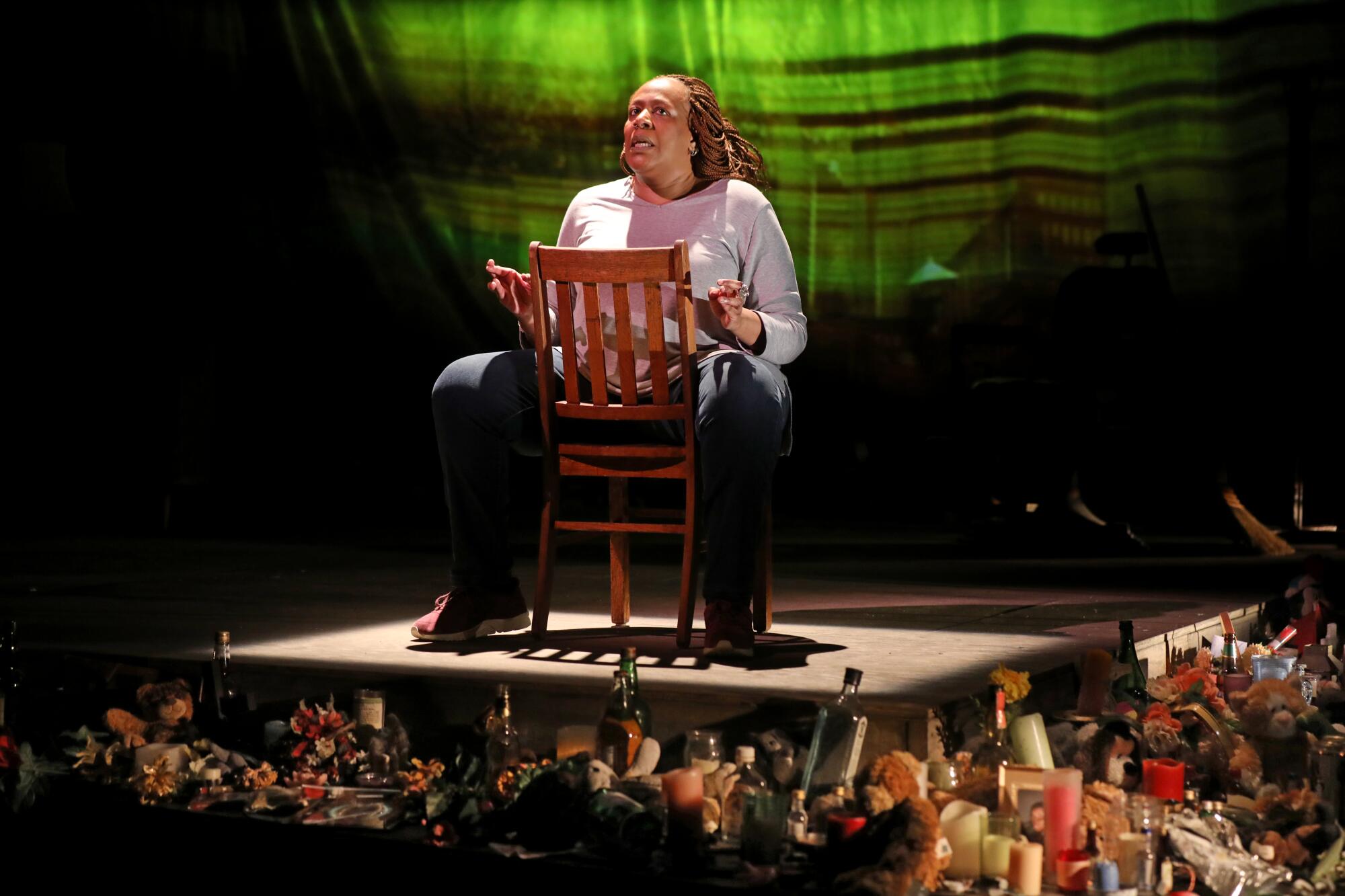
“I’m blessed that I do have work coming in, unlike a lot of people. But have I been affected financially? A major cut.”
New York-based playwright and performer Dael Orlandersmith was speaking on the phone from her new apartment in SoHo. Moving in a pandemic is not ideal, but the time had come to leave her shaggy building in the East Village, where she settled in the 1990s, quickly establishing herself as a powerhouse in the downtown solo performance scene.
Amid all her writing projects, decorating has not been top of mind. In the fall, “Until the Flood” — the solo play about the aftermath in Ferguson, Mo., of the police shooting of Michael Brown, which she brought to the Kirk Douglas Theatre at the start of last year — had its nationwide broadcast premiere via WNET’s All Arts platform.
The political urgency of her poetic voice has brought her commissions for plays and plenty of digital invitations. But Orlandersmith admitted to being “Zoomed out.”
“Performing online is very strange,” she said. “I miss the skin on skin of being in the theater. Other times I can sit and do the Zoom thing. But it does feel intrusive. I am a loner by nature, as most writers are, but when it’s put upon you in this way, it becomes a form of isolation.”
Loneliness has drawn her attention as an artistic subject. She’s been collaborating with David Cale and Matthew Dean Marsh on a multidisciplinary piece called “You Don’t Know the Lonely One.” Like many theater people, she finds connection and community in her work and misses the person-to-person contact that happens through making and seeing live performance.
If her writing has changed in the last year, her focus on personal narrative has not. “I don’t do sociopolitical statements,” she said. “I’m a storyteller who looks at people from all different angles. How is COVID affecting, say, someone older or younger, richer or poorer, white or Black, on a day-to-day basis? Their individual stories, the ways they’re adapting, that is what has been coming before my mind’s eye.”
While plays are her bread and butter, the novel is calling to her. “I’m working on a book of autofiction in my mother’s voice. I did a play called ‘Forever’ a few years back and I was traveling with it and this [new work] is a memoir piece in her voice that’s a response to that play.”
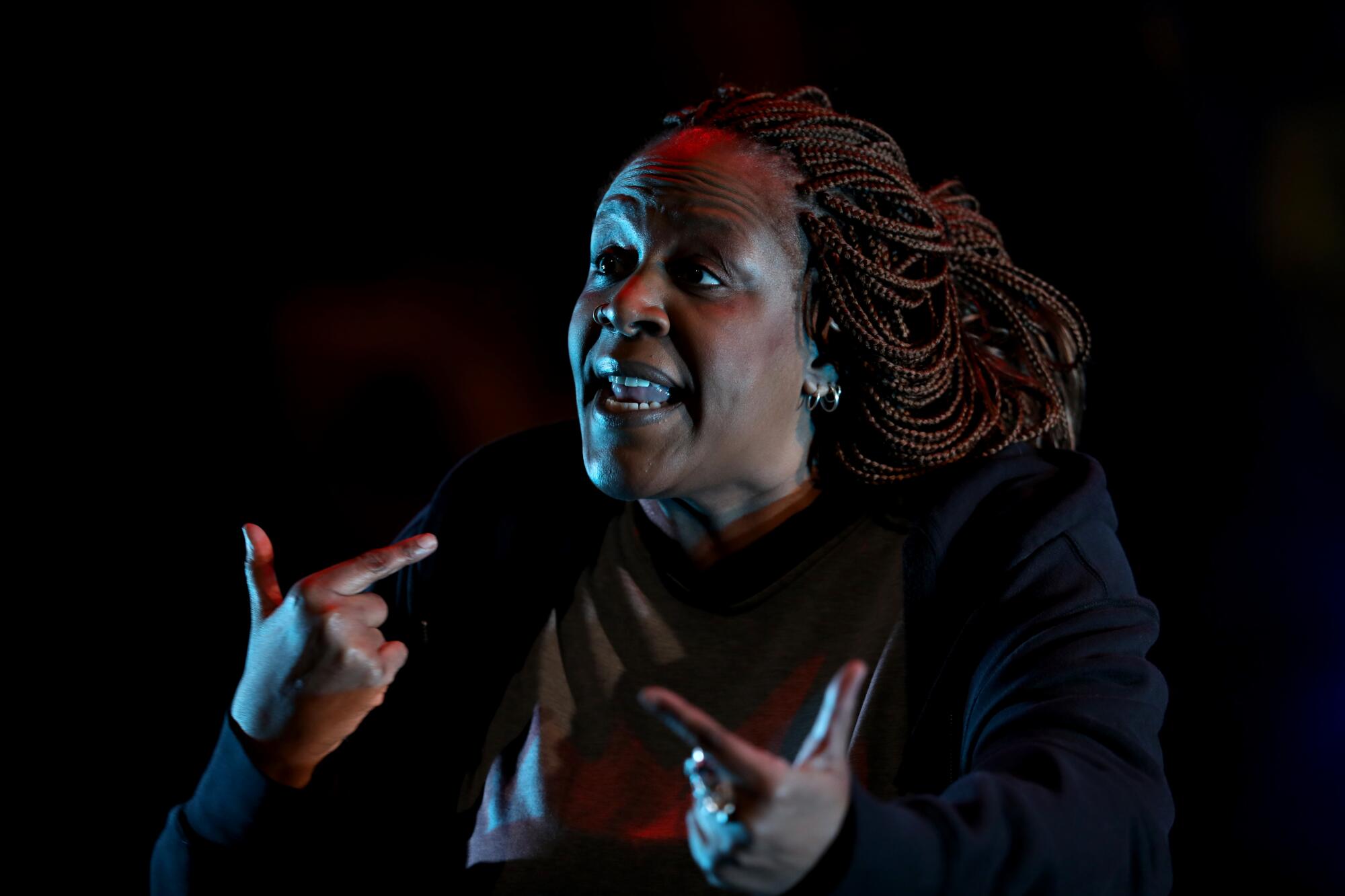
For all her ideas, she wishes she were writing more. “There are days when the depression of being on lockdown makes it tough,” she said. “I miss the ambulatory freedom.” Yet the time alone has made her introspective. “I’ve been looking at how I’ve conducted myself in the world, with people I’ve hurt, things I’ve done, looking at relationships that are no more. The self-inventory is the good thing about this experience.”
Haunting her are the faces of children she was friendly with in her old neighborhood. “They were afraid of the masks,” she said. “They couldn’t just go out to play anymore. I was thinking of how they’re seeing the world through these eyes, of not being able to look at anyone. I’m really feeling for them.”
• • •
Lars Jan
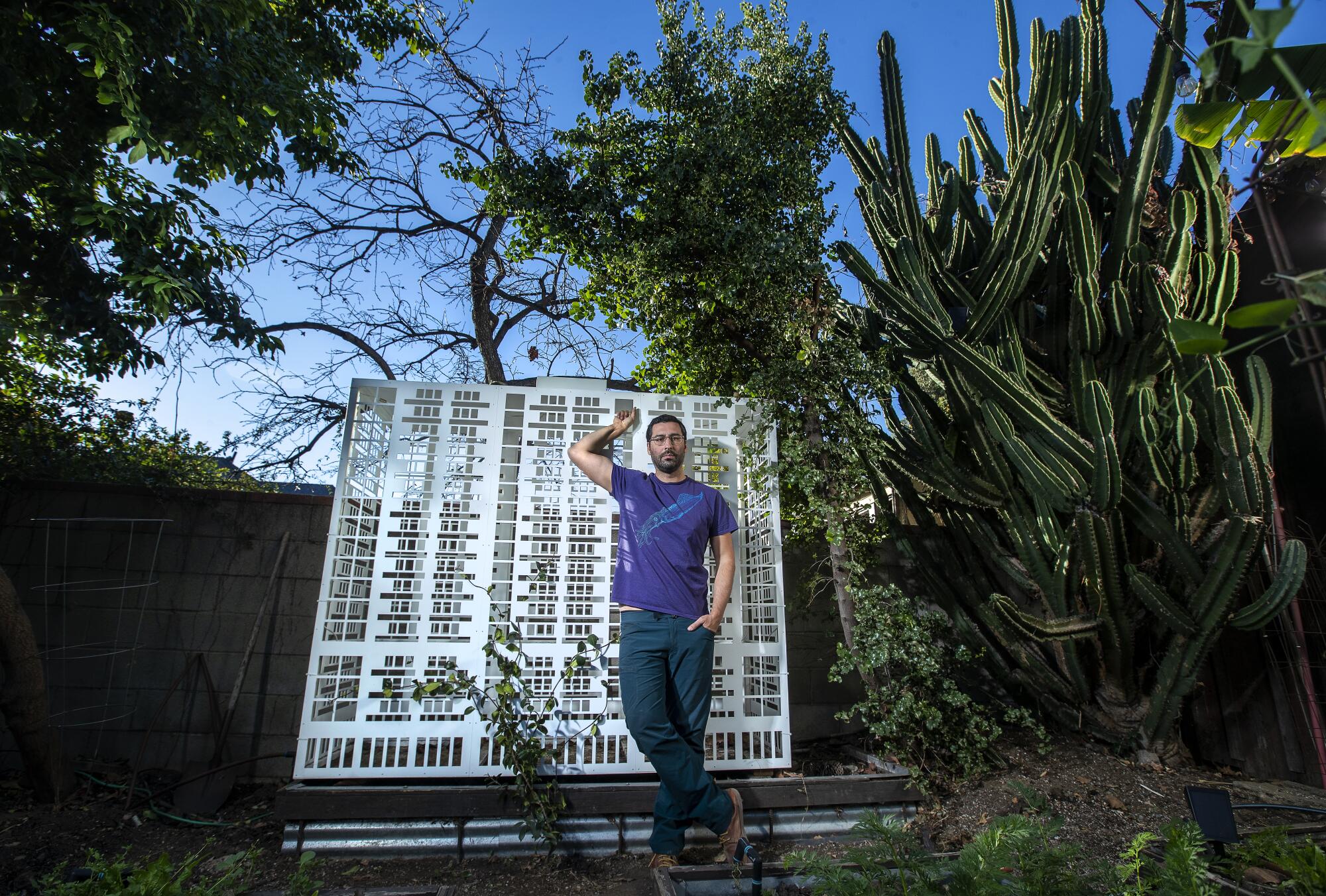
In mid-March of last year, director and visual artist Lars Jan invited friends and colleagues to his downtown Los Angeles studio to see a mock-up of an installation he was planning to bring to the Summer Nostos Festival at the Stavros Niarchos Foundation Cultural Center in Athens.
“The stay-at-home orders were just rolling into effect,” Jan recounted during a recent morning Zoom call. “A few people came to the presentation, and after that I was stuck in my house, which turned into home-schooling for my 8-year-old. We’ve been locked down with my 76-year-old mother, who’s not in great health. Everything became near-field.”
The project in Greece wasn’t the only postponement. Festival TransAmériques offered money to help store another show of Jan’s that had been delayed, first to 2021 and now possibly to 2022, if international touring resumes by then.
More bad news: His production of “The White Album,” a multimedia collage created from Joan Didion’s landmark essay that starred Jan’s wife, Mia Barron, has been retired. The show, presented by UCLA’s Center for the Art of Performance in 2019, was booked for Berkeley in December. But that was of course scratched, and storing the set, which was damaged coming back from the Sydney Festival in Australia early last year, became impossible once Jan decided that it was necessary to give up his downtown workspace.
There was another reason, however, for ending “The White Album.” “The show is predicated on putting 25 college-age students into an unventilated box, in which they share a meal together, creating a community onstage,” Jan explained. “That wasn’t going to be feasible for the foreseeable future, even though the subject of the Black Panthers and the protest movements of the late 1960s was never more relevant than in the aftermath of the George Floyd protests.”
Giving up his studio space has been part of the new abnormal. “There’s been this sense of fragility,” Jan said. “I’ve been living in a house in Echo Park that I’ve co-owned, and the pandemic created a situation where we either had to leave or buy the whole property. We got it together to buy the entire house, and I was able to set up a much smaller studio. Everything just got a lot closer. Some things got hacked off, others have been pushed back.”
Having a “foundational income” through his faculty position at the California Institute of the Arts has allowed Jan to withstand the loss of so much freelance work. Being part of Center Theatre Group’s Creative Collective, which includes a generous honorarium, has also relieved some of the financial stress. As a visual artist, he has more earning options than most directors. Selling some of his prints at the Charlie James Gallery in Chinatown helped him purchase his house. But not even the most interdisciplinary of artists can feel secure in a world in which it’s still not safe to gather.
Although his stage work incorporates video and new technologies, Jan said he hasn’t been personally inspired to dive into digital theater. “Screens for me are a way to talk about culture in real time and in real space,” he said. “But in terms of live performance on screen, I get a lot more out of watching films, which I’ve been doing along with reading more than I have in years.”
Last semester at CalArts, he taught a solo performance lab that was by necessity geared to the virtual realm. An undergraduate, Angela Rosado, opened his eyes not only to new possibilities but also to a profound generational difference.
“Her piece incorporated text, traveling through space, prerecorded video, K-pop, and there was this live stuff about harassment on the street and gender fluidity,” he said. “It was incredibly syncretic. I felt that this artist had climbed inside the internet and was giving me a tour like Virgil in Dante’s ‘Inferno.’”
The 42-year-old Jan was quick to point out that this was not his version of his teenage years or early 20s, his sexual experiences or most of his communication: “She’s 20. It’s a massively different generation than most of the theater makers I’m familiar with who are trying to adapt their practice as opposed to someone for whom this is a native format.”

Peering into his artistic future, Jan plans to forefront his passion for climate activism both thematically and practically in his work. Contact with international artists is essential for him, but he’s trying to figure out how to tour large-scale ambitious projects “without perpetrating terrible violence against the biosphere.”
The political upheaval that came to a head on Jan. 6 with the attack on the Capitol has heightened for him questions about the educational role of the arts in American society.
“Will we ever get past the dumpster fires of issues to have a substantive conversation about the arts?” he asked. “We always have to justify the arts as ‘an economic engine for downtown centers,’ so that’s the only argument that gets made to the broader public. I think the country is where it is because we eviscerated arts education and public education more generally. If people lack empathy and critical thinking skills, that’s a product of the defunding of arts education for the last 40 years.”
• • •
Annie Dorsen
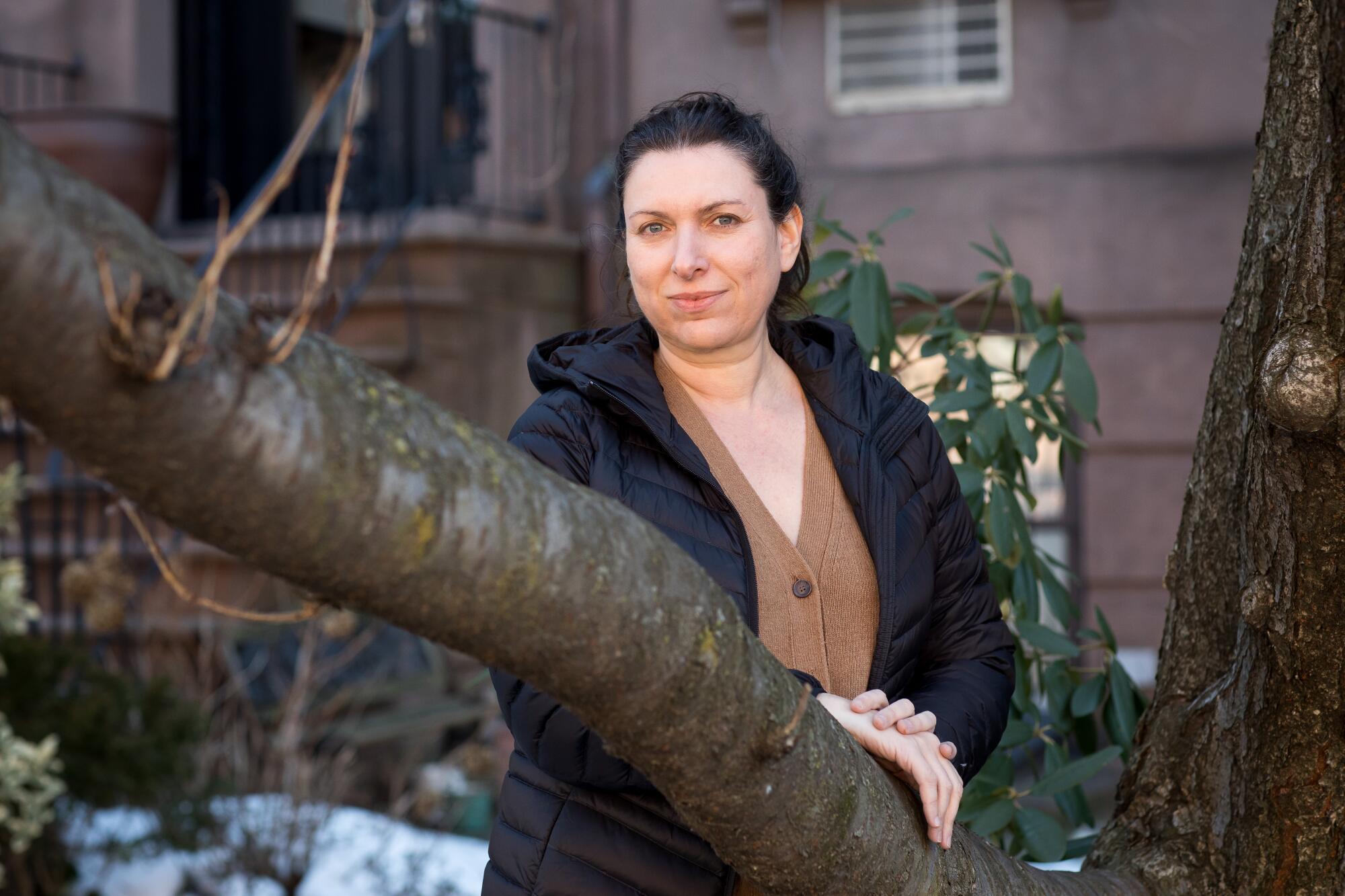
In 2019, experimental director Annie Dorsen was named a MacArthur fellow. A pioneer of “algorithmic theater” — performance that uses computer code to structure a live theater experience — she never imagined that a few months later her touring life would come to a halt, artistic revenue would dry up and Zoom would be her portal to the professional world.
“If it weren’t for the MacArthur, it would really be pretty dire,” she said, shuddering ever so slightly on Zoom. “I have not had any income from my work, except for a few talks here and there and one Zoom workshop.”
When the pandemic hit, she was between projects, happily ensconced in exploratory research. A music theater piece she had lined up with a rock band was scrapped. An upcoming tour was postponed for two years.
“It was so confusing to know in the first few months how long we were talking about,” she said. “At first, it was like, ‘Oh, great time to brush up on my foreign languages.’ But then after a couple of weeks you realize that’s not going to happen. I couldn’t concentrate. I think I dissociated for all of March and April. I was in a news stupor, with the pandemic, the protests and the primaries and the election. So much was going on.”
Eventually she poked around in the world of digital performance but decided that Zoom was not her playground. “I work with technology but in a space where people can gather together at the same time,” she said. “There’s a certain attention and focus that an in-person audience brings. So, in a funny way, I mess with everything in the theater, acting and narrative, but what I don’t mess with is that we come together in a room to share an experience.”
Recognizing that those rooms would be off-limits for a while, she did something “a little bit out of left field.” She started auditing classes at New York University’s law school.
“I thought I would lose my mind if I didn’t have some structure, and it’s an opportunity to do something I’ve always been interested in. For my work, I do all this research on digital technologies, and I kept bumping up against legal debates in the field that I didn’t fully understand. So in addition to feeling that it would be a great time to take constitutional law, I thought it would be useful to explore the public interest side of technology law.”
She has faith that theater will return, and when it does she’ll be back in rehearsal, armed with a deeper understanding of the implications of a world increasingly dominated by automated tools.
“There’s a lot of work, politically and artistically, to do,” she said. “The questions around AI, algorithmic bias and justice, misinformation/disinformation, algorithmic amplification, privacy and surveillance concerns — all these tech issues are now a central part of the political discourse. I remember talking about some of these things a year or two ago, and they hadn’t yet fully broken through. There’s a lot more interest now.”
• • •
Richard Maxwell
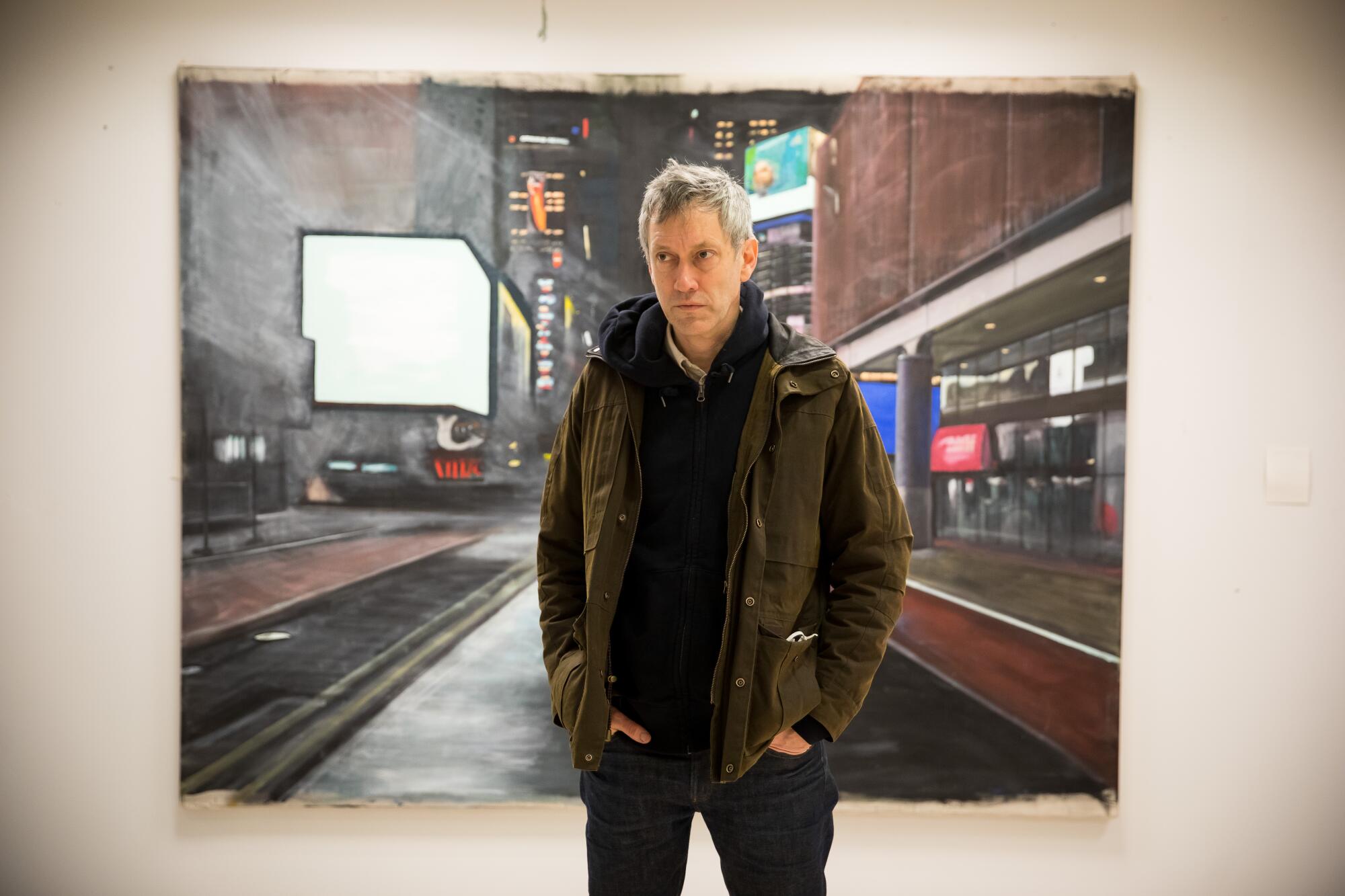
Playwright and director Richard Maxwell had only recently learned that an older piece he was scheduled to present outside Paris in March had been canceled. Postponements have been routine, but cancellations sting.
Yet he was grateful to the organization for compensating his company, New York City Players, with a portion of the artist’s fee. “That was a rare thing,” he said, speaking via Zoom from his home in Midtown Manhattan. “Super classy.”
If crisis reveals character, Maxwell has shown strength in gentleness. He credits the community of support — financial and moral — with getting him through this last year.
“In the beginning it was nice to have an excuse to shelter in place,” he said. “We’re a family of four with a dog. We’re lucky that we have each other and some security.”
As the scale of the situation became clearer, Maxwell, whose experimental aesthetic has turned deadpan neutrality into offbeat stage poetry, was glad to have a company that was small, nimble and not burdened with substantial overhead. “Most of the funding we get is project-based,” he said. “I went on unemployment myself, just so I’m not draining the project money.”
He’s been collaborating on a show with a researcher in Toronto who’s working with the police on deescalation with individuals in mental crisis. He managed to put together a weeklong workshop, which allowed him to hire some artists, as did a project with Incoming Theater Division, the educational wing of New York City Players.
“Every year Incoming Theater Division does a show, which has lately been hosted by the Performing Garage and the Wooster Group,” he said. “We were going to do that in June. But since a live show was not possible, we managed to put together these audio conversations with veterans of the program.”
He said he opted for a listening experience because video “feels overwhelming.” Has digital theater ignited in him any revolutionary ideas?
For Maxwell, the one upside for theater during the pandemic is that it might get us to appreciate what we took for granted. “We’re going to be much more prepared to define what theater is,” he said. “But to answer your question, I just have not had any desire to seek out compelling virtual performances.”
Playwriting has also been on hold. “I bumped into a friend of mine in April, and he was like, ‘You must have written 20 plays by now.’ And I hadn’t written anything. Up until recently, you’d wake up each day and wonder what was going to happen. So you don’t really have a footing. My last play, ‘Queen’s Row,’ which I did in January right before the pandemic, had a sense of finality to it.’”
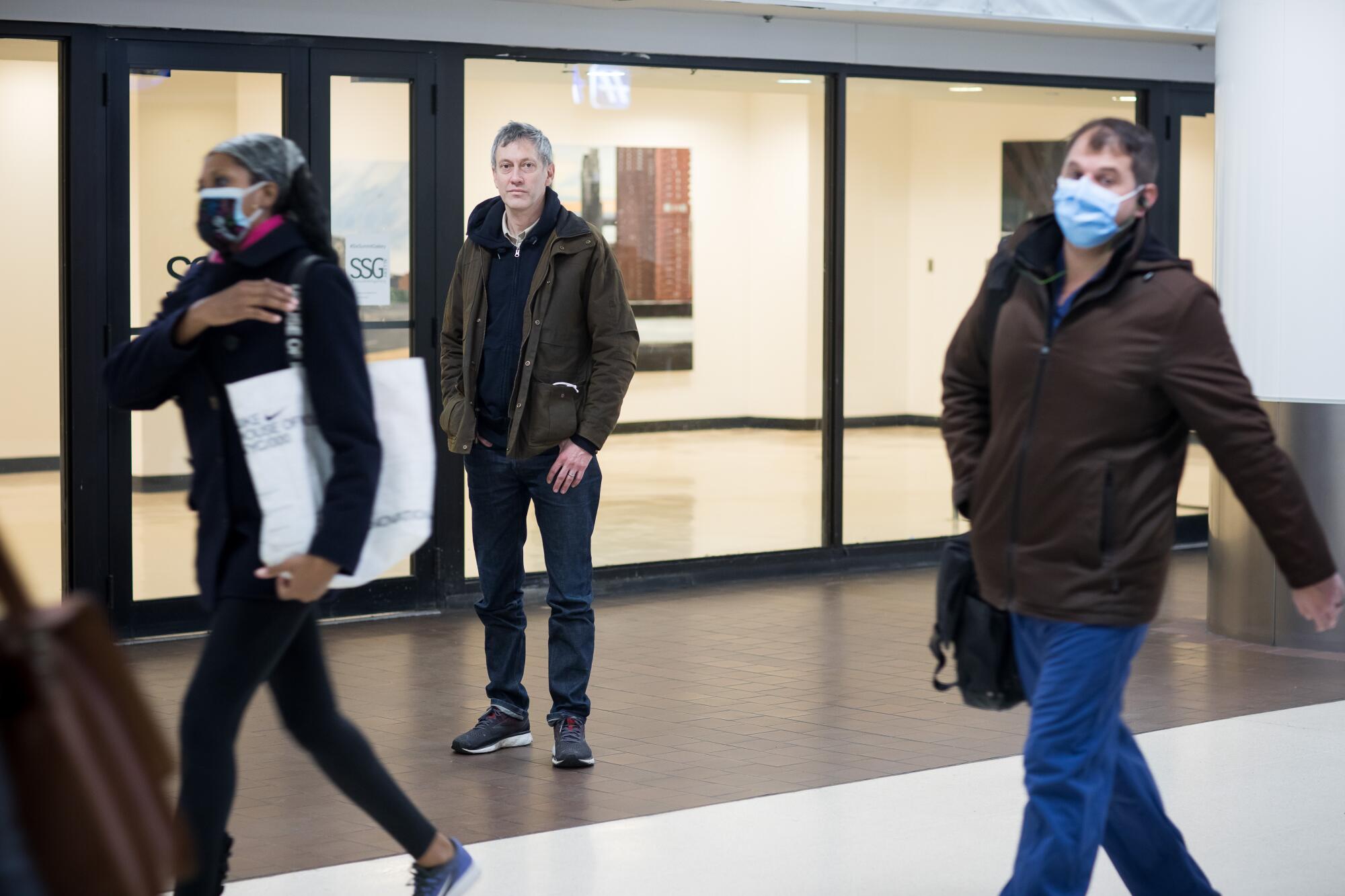
Maxwell shared that there were three deaths in his family in succession: his father in 2014, his mother in 2015, and his sister, esteemed stage actress Jan Maxwell, in 2018. “Jan was the one who convinced me to move to New York from Chicago, and with both of us being in theater, I am still unable to measure the impact of that loss.”
Yet, he had been writing all through his grief. “Everything was in the context of the crazy political landscape that we were in,” he said. “There should be no surprise that the writing had this apocalyptic aspect to it. ‘Queen’s Row’ was imagining civil war in the states. It felt like three or four plays reflected this winding down, this undoing, of what’s been going on nationally.”
While the writer side of him is still sorting through the wreckage, he said painting has been his main creative outlet. A gallery that popped up in Manhattan’s Port Authority Bus Terminal is showing some of his recent works.
“Artists are already really good at surviving,” he said. “I think that training has helped us a lot during this time. I also think we recognize how important it is to help each other. Especially in theater, which is such good empathy training. I’m thinking of Abrons Arts Center, which converted its stage on the Lower East Side to a food pantry. It’s just one example of how people are reaching out to others, realizing as bad as it might be for you, there are people who have it much worse.”
More to Read
The biggest entertainment stories
Get our big stories about Hollywood, film, television, music, arts, culture and more right in your inbox as soon as they publish.
You may occasionally receive promotional content from the Los Angeles Times.
